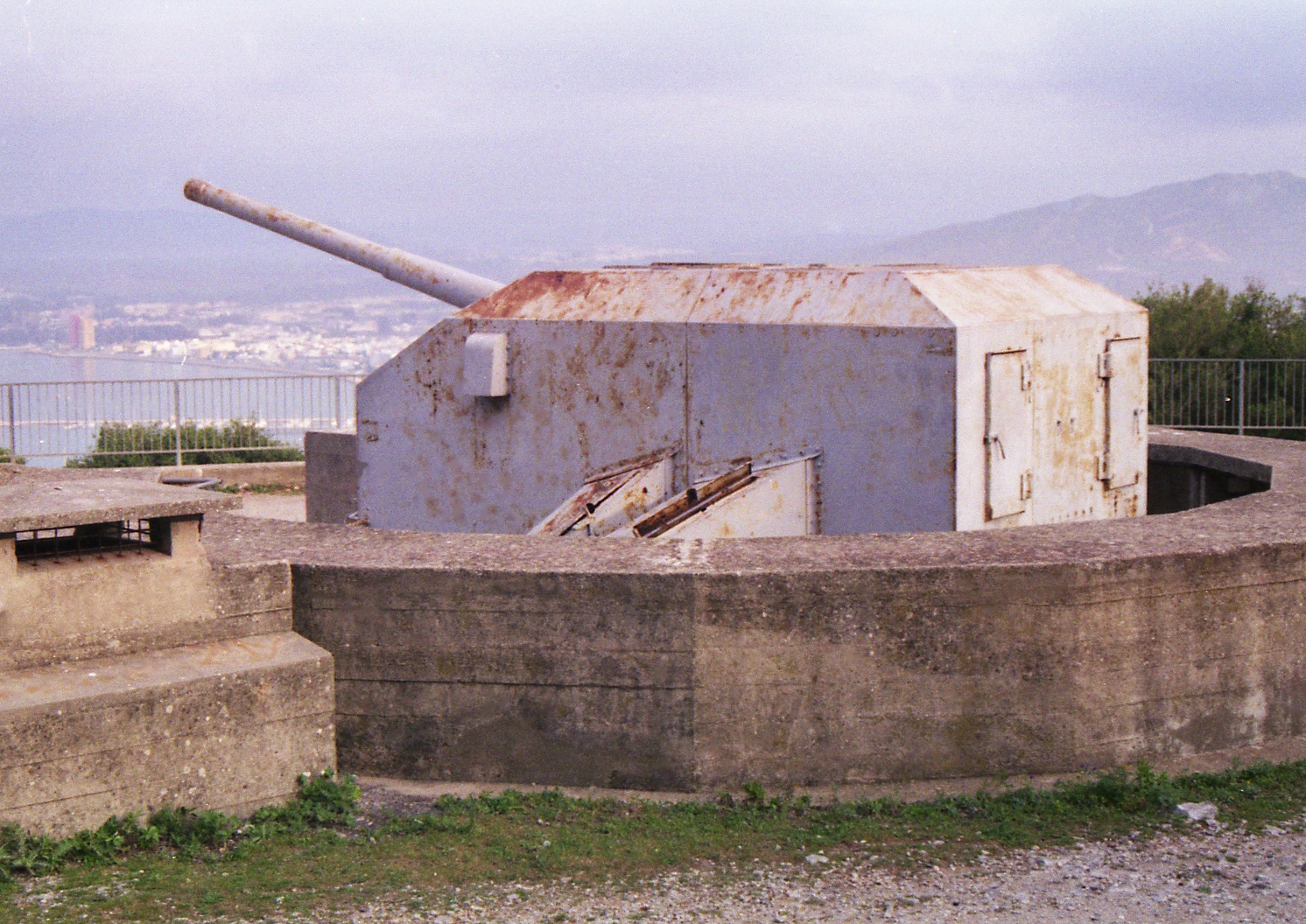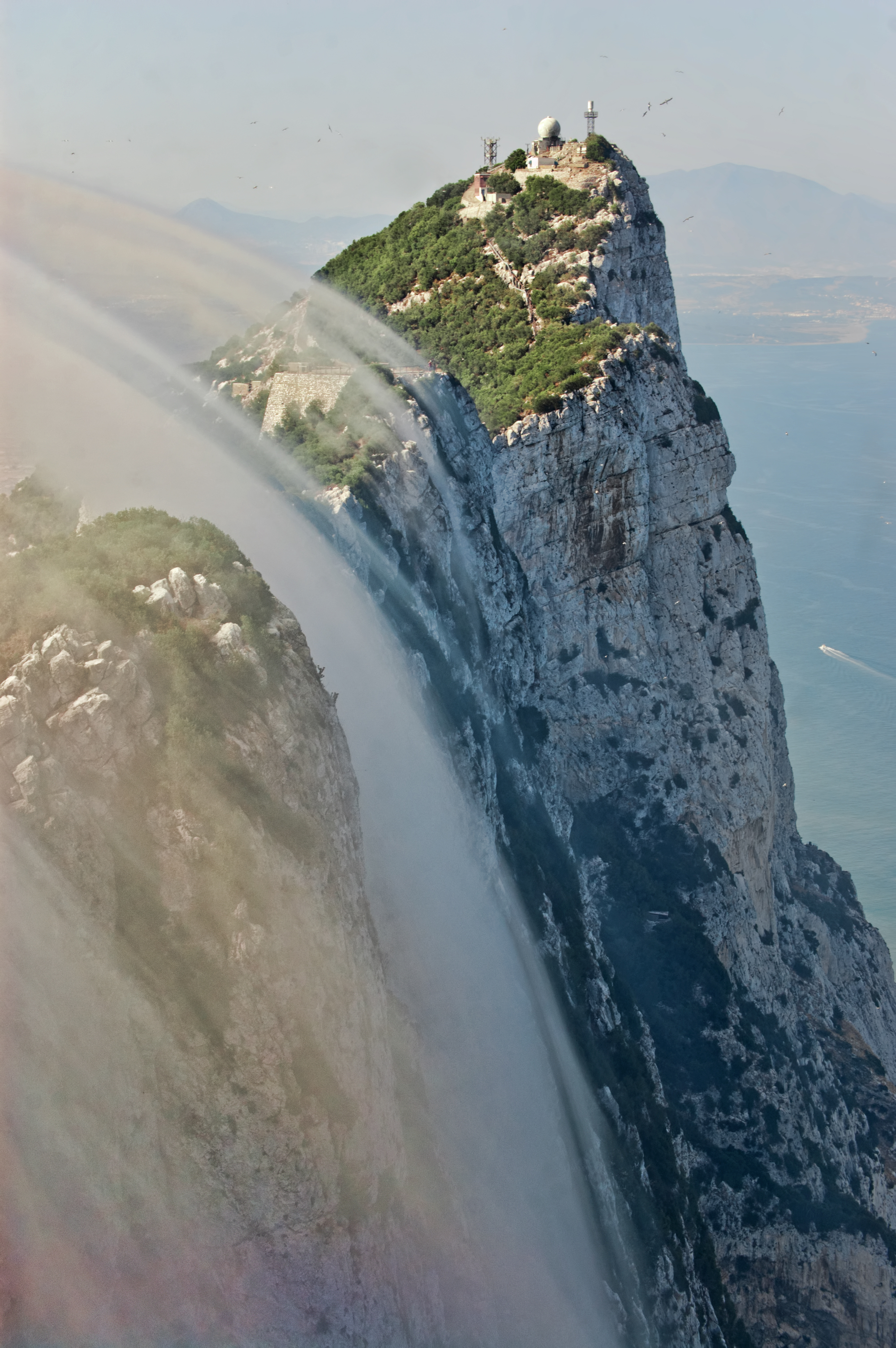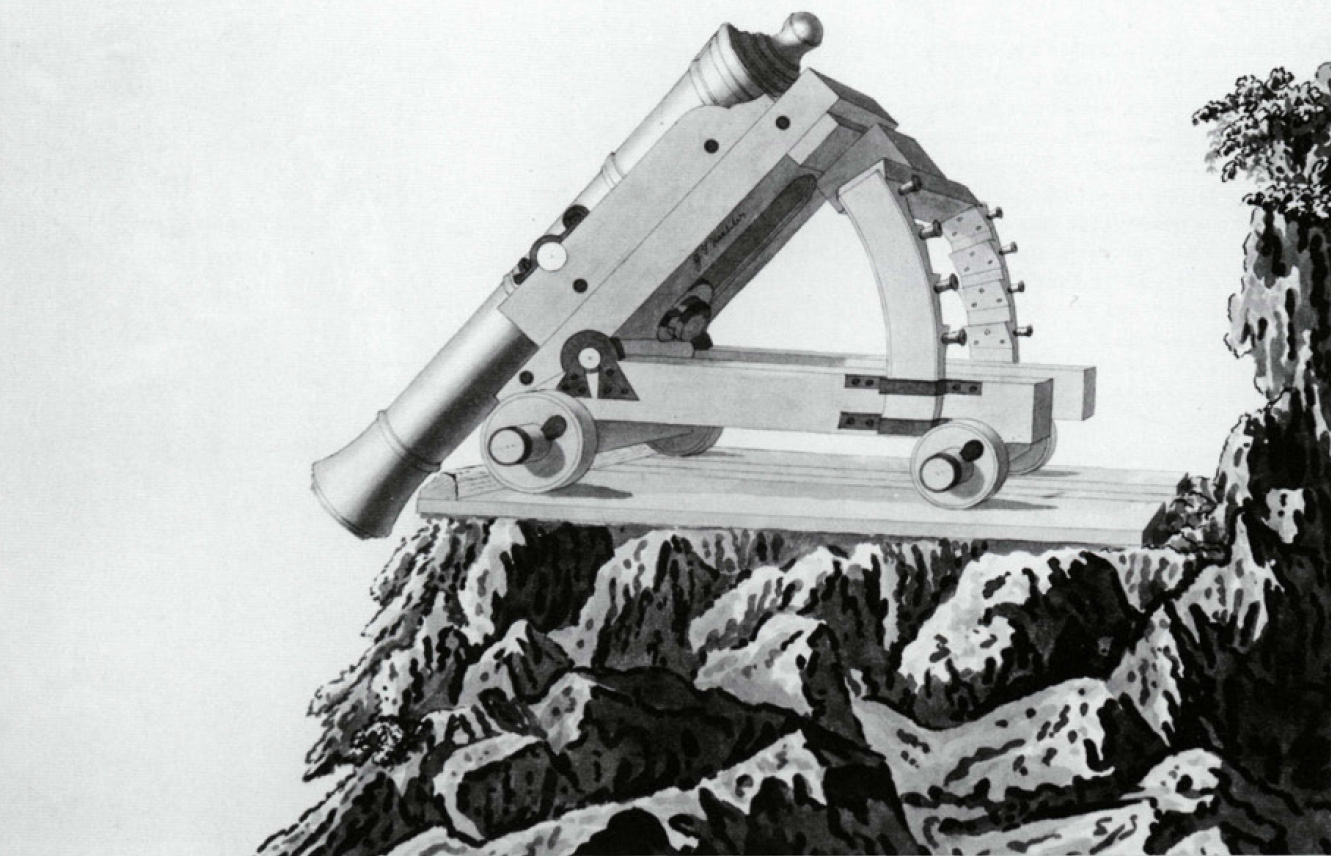|
Spy Glass Battery
Spy Glass Battery or Spyglass Battery was originally a high angle artillery battery in the British Overseas Territory of Gibraltar. The battery is mounted high on the rock to give extra range and protection. The battery was still in use during the Second World War as a listening post and site for a Bofors Gun. Description The six RML 10 inch 18 ton guns here were seen as the culmination of the idea of "retired batteries". Originally most of Gibraltar's guns were on the coast but Major General Sir John Jones realised that setting them higher up the Rock gave them more range and made them more difficult to hit. The six guns here and at the other ridge batteries were as high as guns could be placed. This battery however was different in that this was a high angle battery. There was a growing realisation that the thickness of the armour carried by battleships at the end of the nineteenth century meant that they were almost impossible to penetrate with even the largest gun. A new g ... [...More Info...] [...Related Items...] OR: [Wikipedia] [Google] [Baidu] |
Fortifications Of Gibraltar
The Gibraltar peninsula, located at the far southern end of Iberia, has great strategic importance as a result of its position by the Strait of Gibraltar where the Mediterranean Sea meets the Atlantic Ocean. It has repeatedly been contested between European and North African powers and has endured fourteen sieges since it was first settled in the 11th century. The peninsula's occupants – Moors, Spanish, and British – have built successive layers of fortifications and defences including walls, bastions, casemates, gun batteries, magazines, tunnels and galleries. At their peak in 1865, the fortifications housed around 681 guns mounted in 110 batteries and positions, guarding all land and sea approaches to Gibraltar. Hughes & Migos, p. 91 The fortifications continued to be in military use until as late as the 1970s and by the time tunnelling ceased in the late 1960s, over of galleries had been dug in an area of only . Gibraltar's fortifications are clustered in three ... [...More Info...] [...Related Items...] OR: [Wikipedia] [Google] [Baidu] |
Rock Of Gibraltar
The Rock of Gibraltar (from the Arabic name Jabel-al-Tariq) is a monolithic limestone promontory located in the British territory of Gibraltar, near the southwestern tip of Europe on the Iberian Peninsula, and near the entrance to the Mediterranean. It is high. Most of the Rock's upper area is covered by a nature reserve, which is home to around 300 Barbary macaques. These macaques, as well as a labyrinthine network of tunnels, attract many tourists each year. The Rock of Gibraltar, one of the two traditional Pillars of Hercules, was known to the Romans as ''Mons Calpe'', the other pillar being ''Mons Abila'', either Monte Hacho or Jebel Musa on the African side of the Strait. According to ancient myths fostered by the Greeks and the Phoenicians, and later perpetuated by the Romans, the two points marked the limit to the known world, although the Phoenicians had actually sailed beyond this point into the Atlantic, both northward and southward. The Mediterranean Sea su ... [...More Info...] [...Related Items...] OR: [Wikipedia] [Google] [Baidu] |
Radar
Radar is a detection system that uses radio waves to determine the distance ('' ranging''), angle, and radial velocity of objects relative to the site. It can be used to detect aircraft, ships, spacecraft, guided missiles, motor vehicles, weather formations, and terrain. A radar system consists of a transmitter producing electromagnetic waves in the radio or microwaves domain, a transmitting antenna, a receiving antenna (often the same antenna is used for transmitting and receiving) and a receiver and processor to determine properties of the objects. Radio waves (pulsed or continuous) from the transmitter reflect off the objects and return to the receiver, giving information about the objects' locations and speeds. Radar was developed secretly for military use by several countries in the period before and during World War II. A key development was the cavity magnetron in the United Kingdom, which allowed the creation of relatively small systems with sub-meter resolution. Th ... [...More Info...] [...Related Items...] OR: [Wikipedia] [Google] [Baidu] |
Leslie Cole (artist)
Leslie James Cole (11 August 1910 – 1976) was a British artist and teacher. He served as a war artist from 1942 to 1946 during which time he recorded events in several theatres of war and also the aftermath of the liberation of the Bergen-Belsen concentration camp. Early life Cole was born in Swindon in 1910 and studied lithography and murals at Swindon Art School between 1927 and 1932 before attending Birmingham College of Art for a year. In 1934 he enrolled at the Royal College of Art, where he obtained a diploma in mural decoration, fabric painting and lithography in 1937. He exhibited with the lithography group, the Senefelder Club in 1934 and in 1937 he began teaching at Hull College of Art. Second World War When the Second World War broke out, Cole joined the RAF but was discharged on medical grounds. Cole continued teaching and attempted to obtain work as a war artist from Sir Kenneth Clark and the War Artists' Advisory Committee, but was refused at first. In order ... [...More Info...] [...Related Items...] OR: [Wikipedia] [Google] [Baidu] |
Levant (wind)
The levant ( ca, Llevant, it, Levante, mt, Lvant, el, Λεβάντες, es, Levante) is an easterly wind that blows in the western Mediterranean Sea and southern France, an example of mountain-gap wind. In Roussillon it is called "llevant" and in Corsica "levante". In the western Mediterranean, particularly when the wind blows through the Strait of Gibraltar, it is called the Viento de Levante or the Levanter. It is also known as the Solano. When blowing moderately or strongly, the levant causes heavy swells on the Mediterranean. Usually gentle and damp, the levant frequently brings clouds and rain. When it brings good weather, it is known as the "''levant blanc''",Meteo-France website (in French) on "Vents regionaux and vents locaux" or "''levante calma''" in Gibraltar. The origin of the name is the same as the origin of the Levant, the region of the eastern Mediterranean: it is the Latin word "levante", the participle of levare "to raise" – as in sol levante "risi ... [...More Info...] [...Related Items...] OR: [Wikipedia] [Google] [Baidu] |
Great Siege Of Gibraltar
The Great Siege of Gibraltar was an unsuccessful attempt by Spain and France to capture Gibraltar from the British during the War of the American Revolution. It was the largest battle in the war by number of combatants. The American war had ended with the British defeat at Yorktown in October 1781, but the Bourbon defeat in their great final assault on Gibraltar would not come until September 1782. The siege was suspended in February 1783 at the beginning of peace talks with the British. On 16 June 1779, Spain entered the war on the side of France and as co-belligerents of the revolutionary United Colonies—the British base at Gibraltar was Spain's primary war aim. The vulnerable Gibraltar garrison under George Augustus Eliott was blockaded from June 1779 to February 1783, initially by the Spanish alone, led by Martín Álvarez de Sotomayor. The blockade proved to be a failure because two relief convoys entered unmolested—the first under Admiral George Rodney in 1780 and ... [...More Info...] [...Related Items...] OR: [Wikipedia] [Google] [Baidu] |
George Koehler
George Frederick Koehler (14 January 1758 – 29 December 1800) was a British artist, soldier and engineer. He is known for creating a gun that recoiled allowing it to fire down the side of a mountain without sending the gun carriage flying into the air. The Koehler Depressing Carriage is still commemorated today in Gibraltar where it was an important defence during the Great Siege of Gibraltar. Life Koehler was born in 1758 and baptised in Woolwich. His father was a bombardier born in Rennermuehle, Bavaria, who emigrated to Britain via Hesse and Hannover. He became a second lieutenant in the Royal Artillery in January 1780. Koehler is remembered for his invention of a gun-carriage allowing the axis of the gun to be depressed to an angle of seventy degrees. This was demonstrated during the Great Siege of Gibraltar on 15 February 1782 at Princess Royal's Battery. This new carriage enabled the defending guns to take advantage of the height of the Rock of Gibraltar. Although no ... [...More Info...] [...Related Items...] OR: [Wikipedia] [Google] [Baidu] |
Koehler Depressing Carriage
The Koehler Depressing Carriage was a novel type of gun carriage invented in 1782 by Lt George Frederick Koehler of the Royal Artillery. It was devised to enable cannon to be fired at a steeply downward-facing angle and was made necessary by the peculiar circumstances that the British Army faced during the Great Siege of Gibraltar between 1779–83. The carriage saw active service during the siege, when it was used to support the British counter-bombardment of Spanish and French artillery batteries during the successful defence of Gibraltar. Its success made Koehler famous and has been commemorated in a number of different forms over the last 230 years. Background During the Great Siege, the British garrison of Gibraltar faced a French and Spanish army entrenched on the low ground of the isthmus that links Gibraltar with Spain. The British controlled the high ground of the Rock of Gibraltar, which reaches a height of at its north end. Although this was a major advantage for th ... [...More Info...] [...Related Items...] OR: [Wikipedia] [Google] [Baidu] |
John Thomas Jones
Major General Sir John Thomas Jones, 1st Baronet (25 March 1783 – 26 February 1843) was a British officer in the Royal Engineers who played a leading engineering role in a number of European campaigns of the early nineteenth century. Jones was revered by the Duke of Wellington and asked to advise on fortifications including the modernisation of the defences in Gibraltar. He was also notable as an English amateur cricketer who made six first-class appearances. Biography Sir John Thomas Jones was eldest of five sons of John Jones, esq., general superintendent at Landguard Fort, Felixstowe, Suffolk, and of Cranmer Hall, Fakenham, Norfolk, by his wife Mary, daughter of John Roberts of the 29th foot. He was born at Landguard Fort on 25 March 1783. Sir Harry David Jones was his brother. He was educated at the grammar school at Ipswich, joined the Royal Military Academy, Woolwich in the spring of 1797, received a commission as second lieutenant in the Royal Engineers on 30 August 1 ... [...More Info...] [...Related Items...] OR: [Wikipedia] [Google] [Baidu] |
Gibraltar
) , anthem = " God Save the King" , song = " Gibraltar Anthem" , image_map = Gibraltar location in Europe.svg , map_alt = Location of Gibraltar in Europe , map_caption = United Kingdom shown in pale green , mapsize = , image_map2 = Gibraltar map-en-edit2.svg , map_alt2 = Map of Gibraltar , map_caption2 = Map of Gibraltar , mapsize2 = , subdivision_type = Sovereign state , subdivision_name = , established_title = British capture , established_date = 4 August 1704 , established_title2 = , established_date2 = 11 April 1713 , established_title3 = National Day , established_date3 = 10 September 1967 , established_title4 = Accession to EEC , established_date4 = 1 January 1973 , established_title5 = Withdrawal from the EU , established_date5 = 31 January 2020 , official_languages = English , languages_type = Spoken languages , languages = , capital = Westside, Gibraltar (de facto) , coordinates = , largest_settlement_type = largest district , l ... [...More Info...] [...Related Items...] OR: [Wikipedia] [Google] [Baidu] |










